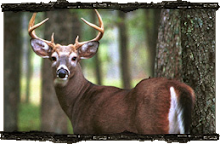This fall, both projects, Apple Tree Release and Food Plots received much attention. One of our active volunteers, Andy Nagle accompanied Steve Goodwin, Dean of U. Mass. Dept of Agriculture and Natural Science. Dean Goodwin was especially interested in our Apple Tree Release Program, and has offered any help. Thanks to his department, we have learned that the Quimby Pond apple trees are called "winter banana". The ones we ate, were surprising sweet and delicious for stressed trees. We have now completed the first phase of clearing more sunlight for 34 apple trees. We await another consulting visit from Steve's colleague in the spring, to determine if the larger competing trees should be professionally removed.
Bob Cordes, deer biologist from IF & W,, has made two trips to our Rangeley plots. He was impressed how much deer and moose use the Cross-Town plots. He felt that the clover is solidly established and will produce adequately the next few years. He recommended we replant with the annuals, buckwheat and oats to help the does produce strong offspring this early summer. He thought over-planting forage turnip along the periphery next year would help the deer's winter endurance. On a second trip, he visited the Flat Iron Plot, and confirmed late-season deer usuage, as the deer migrate through this area on the way into Oqoussoc. Planting the annuals, Turnip and buckwheat will be considered here as well. The control plot did fairly well, probably germinating 30% because its soil ph was pretty good to start with. Bob, you will recall, was the biologist that helped Marcia to design the Rangeley Seed Mix. In the picture, he is looking at some of the ryegrass, and pleased with the obvious success of the plots. We are lucky to have such close access to the expertise Bob Cordess and Chuck Hulsey.

Bob and his little girl, Madison, accompanied Marcia, Ron Ray and Kent Cummings to visit some new potential plots for next year.
Bob agreed with Ron Ray, Guide and Moniter, that these plots met all the criteria: south-facing, along the winter deer corrider, good drainage and good cover. Ash will again be used. This location will be proposed to Seven Islands.
Our visitor, Andy Weik, grouse biologist from Ruffed Grouse Society gave us a very educational presentation on managing grouse and woodcock habitat. This can be done maintaining habitats of various ages. Ruffed grouse are most common in patches that are covered by trees 5-15 years old. The land-owner should strive to maintain forest of different ages. Harvesting a 5-10 acre every 10 years easily provides a mix of age classes. So folks, remember that small clear-cuts are the best thing we can do for all our wildlife. Another excellent technique is cutting down strips of alder to give woodcock more access to earthworms, their main food source. A chainsaw is the best friend of most wildlife.
While touring our plots, Andy recommended cutting a few narrow corriders entering the plots. This would better serve woodcock and other wildlife. He also discovered that rabbits have been browsing the plots that had good cover. Prior to his presentation, Andy also got a chance to hunt grouse with Rick Baker.
If any of you are interested in learning more, please join the Ruffed Grouse Society 888-564-6747. The quarterly magazine is really excellent.



No comments:
Post a Comment